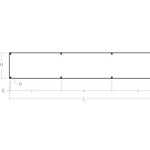Essential Aspects of Gel Stain for Kitchen Cabinets
Gel staining kitchen cabinets is a popular and effective method for transforming the look of your kitchen. However, to achieve the best results, it is essential to understand the key aspects of gel stains and how they can impact the final outcome.
This guide will explore the crucial elements of gel staining, including the properties, application techniques, and factors to consider when selecting the right gel stain for your kitchen cabinets.
Properties of Gel Stains
Gel stains are thick, pigmented finishes known for their ease of application and ability to create a durable and even finish. They are made from a blend of resin, solvents, and pigments and possess several unique properties:
- Thick Viscosity: Gel stains have a thicker consistency than traditional oil-based stains, allowing them to be applied smoothly and evenly without drips or runs.
- Gelled Form: The gel-like form of these stains prevents them from penetrating too deeply into the wood, resulting in a more superficial finish that preserves the natural grain.
- Controlled Penetration: Gel stains offer greater control over penetration depth, allowing you to achieve various shades and effects by applying multiple layers.
- Durability: Gel stains are highly durable and provide a long-lasting finish that is resistant to wear, scratches, and fading.
Application Techniques
Applying gel stains correctly is crucial for achieving a professional-looking finish. Follow these steps to ensure proper application:
- Surface Preparation: Clean and sand the cabinet surfaces to remove any dirt, grease, or old finish.
- Stain Application: Apply a thin layer of gel stain using a brush or sponge, following the grain of the wood.
- Working Time: Allow the stain to sit for the recommended time (typically 15-30 minutes) before wiping off excess.
- Wiping: Use a clean cloth or sponge to wipe away the excess stain in the direction of the grain, revealing the desired color intensity.
- Multiple Coats: For a richer color, apply additional layers of gel stain, allowing each coat to dry completely.
- Topcoat: Seal the stained cabinets with a polyurethane topcoat to protect the finish and enhance durability.
Factors to Consider When Choosing Gel Stain
When selecting a gel stain for your kitchen cabinets, consider the following factors:
- Color: Choose a color that complements the kitchen's overall design scheme and personal preferences.
- Wood Species: Different wood species absorb stains differently, so test the stain on a small area to ensure compatibility.
- Finish: Gel stains can be used to create matte, satin, or glossy finishes, depending on the desired look.
- Brand: Opt for reputable brands that offer high-quality gel stains known for their performance and durability.

Gel Staining Kitchen Cabinets 6 Month Review Merrypad

Pickled Oak Bathroom Vanity Before And After Gel Stain Staining Cabinets Kitchen Makeover Wood

Java Gel Stain Kitchen Transformation General Finishes Design Center

10 Best Gel Stain Tips For Beginners Budgeting Bliss

Gel Stain Kitchen Cabinets Without Sanding Fast Easy Diy

How To Gel Stain Cabinets Printable She Buys He Builds

Gel Stain 101 When And How To Use It Bob Vila

How To Use Gel Stain On Cabinets The Good Bad

Gel Staining Kitchen Cabinets For An Easy Thrifty Update

How To Paint Cabinets With Java Gel Stain My Homier Home








